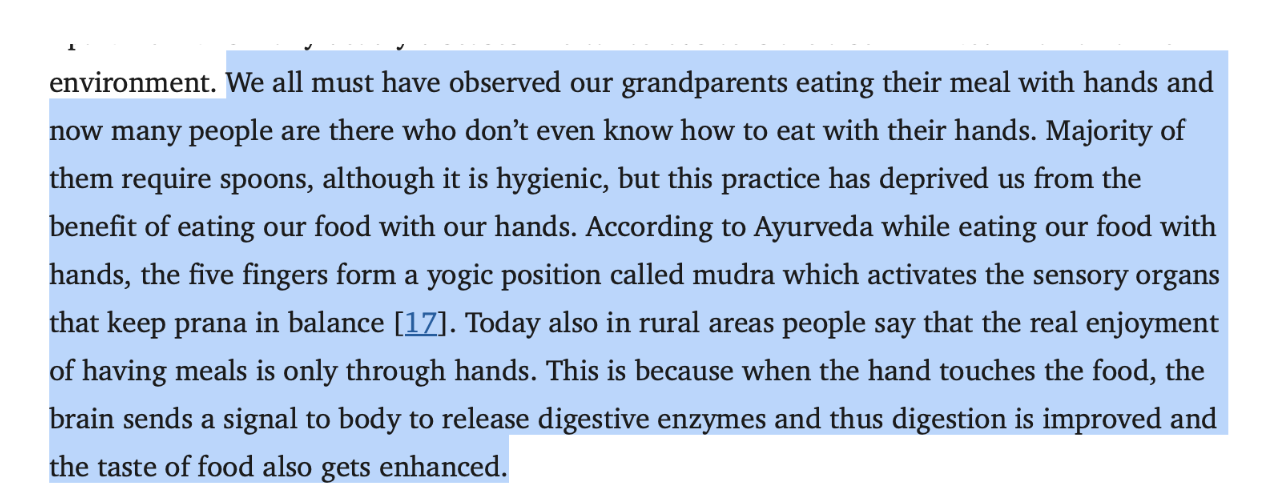Imagine sitting down for a meal eating with hands, not in a rush, not distracted, just as generation before us did. Your fingers gently touch the food, sensing its warmth, texture, and consistency before it even reaches your mouth. In that moment, eating becomes more than just consuming; it becomes an experience, a connection between you and your food.
Long before forks, spoons, and knives became the norm, our ancestors followed a simple practice—eating with their hands.
Throughout history, cultures across the world relied on their hands to eat. For example, Egyptians, Mesopotamians, and Greeks were some of the most advanced civilizations of their time—practiced eating with their hands, understanding that it wasn’t just a habit but a way of intuitively preparing the body for digestion.
In India, eating with hands has been a sacred tradition rooted in Ayurveda, which emphasizes the role of touch in stimulating digestive enzymes and balancing the body’s energies. Even today, millions across the country follow this practice, believing that the connection between food and fingers promotes better digestion and enhances the enjoyment of meals.
Indigenous cultures around the world—from Africa to South America, continue to eat with their hands, not just as a cultural practice but as a holistic way of consuming food.
There are ample examples.
And modern research now validates what ancient wisdom already knew—there’s a scientific reason behind eating with hands, and it goes beyond just convenience.
The human body is designed to interact with food at multiple levels—visually, aromatically, and through touch.
Ayurveda’s Perspective: Eating with Hands as a Digestive Enhancer
According to Ayurveda, our fingers aren’t just tools for eating—they represent the five elements (Panchamahabhuta) that govern the universe and our body:
- Thumb (Fire): Governs metabolism and transformation.
- Index Finger (Air): Regulates movement and circulation.
- Middle Finger (Space): Creates balance and expansion.
- Ring Finger (Earth): Represents stability and structure.
- Little Finger (Water): Supports fluid balance and digestion.
When we eat with our hands, we’re not just following tradition; we’re engaging with these elements, activating our prana (life force energy), and deepening our connection with food. This practice stimulates digestion, enhances nutrient absorption, and ensures that food is broken down efficiently.

Another key benefit of eating with hands is that it encourages mindfulness. It slows down the process, engaging all our senses—touch, smell, and taste—so that we truly experience every bite. When we eat with awareness, digestion improves, and the body assimilates nutrients more effectively.
Ayurveda teaches that digestion is not just about what we eat but how we eat. The simple act of eating with hands, something our ancestors intuitively practiced, holds wisdom that modern science is now beginning to validate.
The Gut-Brain Connection: How This Habit Boosts Digestion
The way we eat directly influences our gut health. Eating with hands is still one of the most overlooked habits. It’s not just cultural—it’s deeply rooted in physiology.
Let’s know how.
- Activates the Gut-Brain Axis: The moment your fingers touch food, your brain gets the message to prepare for digestion. It stimulates the gut-brain axis, enhancing saliva production, digestive enzyme release, and gut motility (the movement of food through the digestive tract). It helps reduce bloating, indigestion, and discomfort.
- Introduces Beneficial Bacteria: Our hands naturally carry beneficial bacteria that contribute to gut health. When we eat with our hands, we expose our gut to these microbes in small amounts, supporting microbial diversity and such exposure primes the immune system and aids digestion.

At its core, why Indians eat with hands is not just about tradition—it’s about encouraging a deeper connection with food.
Psychological Benefits of Eating with Hands
Beyond digestion, eating with hands also has an impact on our minds and emotions. It helps regulate stress, encourages mindfulness, and encourages a healthier relationship with food.
- Enhances Sensory Satisfaction: Engaging multiple senses while eating—touch, smell, sight, and taste—enhances satiety, making you feel full and satisfied with less food. Sensory engagement also helps prevent overeating, which is a common cause of digestive distress.
- Reduces Stress and Lowers Cortisol Levels: Digestion and stress are deeply connected. When stress levels are high, digestion slows down, leading to bloating, acidity, and poor nutrient absorption. Eating with hands naturally promotes mindfulness, which has been shown to lower cortisol (the stress hormone) and improve overall gut function.
- Strengthens the Connection Between Food and Gratitude: Eating with hands promotes a deeper bond with food, transforming meals into an intentional and fulfilling experience rather than just another task. In Indian culture, it is considered a sacred practice—one that nurtures gratitude for the nourishment we receive.
How to Eat with Hands Mindfully (Without Mess or Discomfort)
If you’ve never tried eating with hands, you might wonder, how do you do it without making a mess?
The good news is that this practice is not about grabbing handfuls of food but about eating with intention, control, and refinement.
Here’s how you can embrace eating with hands comfortably while reaping its many benefits:
1. Begin with Clean Hands
Before you start, always wash your hands thoroughly with soap and water. This not only ensures hygiene but also signals to your brain that it’s time to eat. Ayurveda emphasizes cleanliness as an essential part of mindful eating, and science backs this up—clean hands reduce the risk of infections while maintaining the natural balance of beneficial bacteria on the skin.

2. Use Your Fingertips, Not the Entire Palm
One of the biggest misconceptions about why Indians eat with their hands is that they scoop up food with their entire palm. In reality, it’s a much more refined process. Use only your fingertips to mix and pick up food, ensuring that your palm stays clean. This method allows for better control and a neater eating experience while still engaging the senses.
3. Mix and Feel the Food for a Sensory Experience
Unlike cutlery, which creates a disconnect between food and the body, eating with hands allows you to feel the texture, temperature, and consistency of your meal. In Ayurveda, this touch-based connection helps activate the gut-brain axis, preparing your digestive system even before the food reaches your mouth.
When mixing rice, lentils, or vegetables, do so gently with your fingers—this not only enhances the experience but also helps food combine better, making it easier to digest. The warmth of your hands also plays a role in softening food, making it gentler on your stomach.
4. Take Smaller Bites and Chew Slowly
One of the benefits of eating with hands is that it naturally slows down your eating pace. When you take smaller bites and chew thoroughly, you allow digestive enzymes to work effectively, reducing bloating and improving nutrient absorption.
5. Clean Your Hands Mindfully for a Complete Experience
In many traditional cultures, a meal doesn’t end until hands are cleaned properly. Whether you prefer wiping your hands with a napkin or rinsing them in a finger bowl, this simple act adds a sense of closure to your meal. It’s also a great way to reinforce mindfulness—just as you began your meal with awareness, you complete it with gratitude.
Switching to eating with hands may feel unfamiliar at first, but over time, it becomes second nature.
The Back-to-Roots Approach: Reconnecting with Ancient Wisdom
We’re always looking for the next big health trend, yet some of the most powerful habits are the ones we’ve left behind. In the rush toward modernity, we’ve traded mindfulness for convenience, often forgetting that how we eat is just as important as what we eat.
Eating with hands isn’t just a tradition—it’s a way to slow down, engage our senses, and build a deeper connection with both our food and our body.
Here’s a simple challenge: for just one meal, put aside the fork and spoon:
- Use your hands.
- Feel the texture of your food before it even reaches your mouth.
- Notice the warmth of fresh-cooked rice, the softness of lentils, and the crispness of vegetables.
- Pay attention to how it changes your experience of eating.
Then ask yourself:
- Does it make you more present?
- Do you eat slower?
- Do you chew more consciously?
This isn’t about giving up cutlery altogether—it’s about experimenting with a small but meaningful shift.
So, try it.
One meal, no distractions, just you, your food, and your senses fully engaged.
Disclaimer: This blog is for informational purposes only and is not a substitute for professional medical advice, diagnosis, or treatment. If you have specific health concerns, digestive issues, or medical conditions, consult a qualified healthcare practitioner before making nutritional or lifestyle changes. Always ensure proper handwashing before meals to maintain hygiene and prevent contamination.
In a world that glorifies complexity, simplicity is the ultimate luxury—and the wisdom of our ancestors holds the key.
Back to the Roots: Celebrating Indian Wisdom and Wellness is more than a book—it’s a wake-up call to reclaim the time-tested traditions that nourish our body, mind, and soul.
If you’re ready to bring these ancient principles into your daily life and experience true, lasting wellness, our team is here to guide you every step of the way.
Schedule a one-on-one consultation with our experts by calling us at 1800 102 0253 or emailing us at [email protected].










